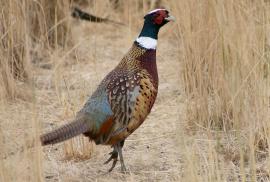Guide to Boreal Birds
Overview
The North American birds of this species are descended from stock brought from several different parts of the Old World and thus are somewhat variable. They are very tolerant of humans and can get by with a minimum of cover; they often nest on the outskirts of large cities. Although successful in most grassland habitats, this species has its North American headquarters in the central plains. After the breakup of winter flocks, males establish large territories and mate with several females. At first the chicks feed largely on insects but soon shift to the adult diet of berries, seeds, buds, and leaves. The Ring-necked Pheasant is also the state bird of South Dakota.
Description
30-36" (76-91 cm). Larger than a chicken, with a long pointed tail. Male has red eye patch, brilliant green head, and (usually) white neck ring; body patterned in soft brown and iridescent russet. Female mottled sandy brown, with shorter tail.
Voice
Loud crowing caw-cawk! followed by a resonant beating of the wings. When alarmed flies off with a loud cackle.
Nesting
6-15 buff-olive eggs in a grass-lined depression concealed in dense grass or weeds.
Habitat
Farmlands, pastures, and grassy woodland edges.
Range/Migration
Introduced from British Columbia, Alberta, Minnesota, Ontario, and Maritime Provinces south to central California, Oklahoma, and Maryland. Native to Asia.



